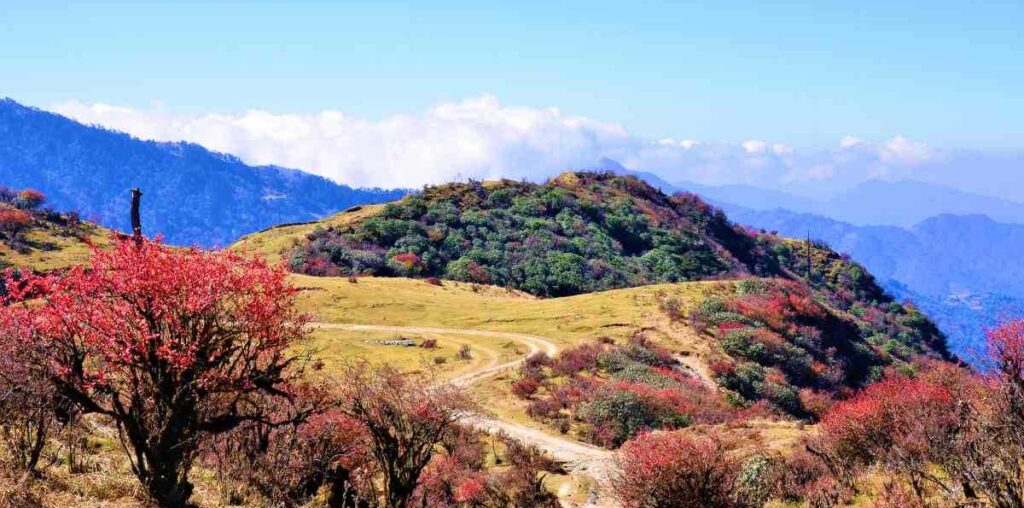Located in the northeastern part of India, Singalila National Park is a pristine and serene sanctuary that attracts nature lovers, wildlife enthusiasts, and adventure-seekers. Situated in the state of West Bengal, this park is known for its breathtaking landscapes, diverse flora and fauna, and sceneries of the surrounding mountains. It is a beautiful blend of natural beauty, biodiversity, and peacefulness, hence one of the most visited national parks in the region. In this article, we will explore the beauty and uniqueness of Singalila National Park, its location, and the animal species that make it famous.
Singalila National Park: Location and Accessibility
Situated in the Darjeeling district of West Bengal on the ridges of the Singalila Range in the eastern Himalayas, Singalila National Park lies strategically along the international border between India and Nepal, offering a diverse ecological landscape as well as a rich cultural backdrop. Due to its proximity to the famous hill stations of Darjeeling and Kalimpong, it is quite accessible for any tourist interested in discovering the natural charm of the place.
The park is located around 24 km from Darjeeling town and has good road connectivity with cities such as Kolkata and Siliguri. Nearest railhead from the Singalila National Park is NJP i.e. New Jalpaiguri Railway Station while the nearest airport is the Bagdogra Airport about 50km away from there. There the visitors have taxis and buses facility going to entry of the park from these spots but once one entered the park each moment on their journey through a landscape is enjoyed being so scenic and peaceful.
Beauty of Scenic Treks:
Singalila National Park is very beautiful, with high peaks, lush forests, alpine meadows, and crystal-clear rivers. The altitude ranges from 7,000 to 12,000 feet, offering some of the best views of the tallest peaks in the world, including the mighty Kanchenjunga, the third highest mountain on Earth. It consists of dense temperate forests, bamboo groves, rhododendron bushes, and alpine meadows, with wildlife species galore.
For a trekker, Singalila National Park is a heaven. The Singalila Ridge Trek is one of the most widely followed trek routes, which, in fact is a unique trek as the route passes through thick forests, verdant valleys, and mountain ridges. The trek leads visitors to various vantage points from which one can obtain great views of the surrounding peaks, including majestic Kanchenjunga and Mount Everest among other peaks within the Himalayas. The route is also seen as a trekking route for witnessing some of the many rare and endangered species in the park.
Singalila National Park in Which District?
Singalila National Park is situated within the Darjeeling district in West Bengal. Darjeeling is a popular hill station that attracts thousands of tourists every year for its pleasant climate, tea gardens, and views of the Himalayas. The park is located along the western edge of the Darjeeling district, and it is a part of the Darjeeling-Chalsa forest division. The district is famous for its tea estates, toy train rides, and the breathtaking views of the snow-clad peaks of the Eastern Himalayas.
Flora and Fauna at Singalila National Park
Singalila National Park is known for its exquisite biodiversity; in fact, this park is adorned with a variety of flora and fauna. The park’s vegetation ranges from low-altitude subtropical forests to temperate forests, alpine meadows, and tundra vegetation with such high altitudes. The diverse habitats accommodate a large population of different species of animals, birds, and plants.
Flora of Singalila National Park
Then, the flora of the park remains just as diverse with a large variety of plant species flourishing here under different climatic conditions. The forests of the Singalila National Park consist mainly of oak, pine, birch, and rhododendron trees, further complemented by diverse species of bamboo. The rhododendrons in the spring season bring vibrancy and color to the park, attracting visitors and pollinators alike. Other notable plants include medicinal herbs, ferns, and alpine flowers that add beauty to the natural beauty of the park.
Fauna of Singalila National Park
Singalila National Park is also known for a wide variety of wildlife, consisting of several endangered species that have found shelter in its pristine environment. The park has numerous animals, birds, and reptiles, many of which are originally from the Himalayan region.
The Red Panda (Ailurus fulgens) is probably the most prominent inhabitant of the park small, mysterious mammal recognized by its distinctive reddish coat and playful activities. The red panda is actually the flagship species of Singalila National Park and one of the primary reasons for the popularity of the park in the eyes of wildlife enthusiasts. It is listed as endangered on the International Union for Conservation of Nature (IUCN) Red List due to habitat loss and poaching. The park is an important conservation area for this rare and elusive animal.
Other notable mammals found in Singalila National Park include:
Himalayan Black Bear: A bear species found in the Himalayan forests, known for its black fur and distinct white chest markings.
Clouded Leopard: A rare and elusive predator that thrives in the dense forests of the park.
Barking Deer: A small deer species commonly found in the foothills of the Himalayas.
Sambar Deer: A large deer species that roam the park’s dense forested areas.
It is also a habitat for different bird species, which is why many visit the park for birdwatching. Some of the most notable bird species include:
Blood Pheasant: A vibrant red-plumed bird, this species is natively found in the Himalayas and can be spotted in the park.
Yellow-billed Blue Magpie: This is a brightly coloured bird with striking blue and yellow plumage that is often seen flitting through the trees.
Satyr Tragopan: A large and rare pheasant species that is found in the eastern Himalayas and a sight for birdwatchers.
Steppe Eagle: A migratory bird that could be seen soaring over the alpine meadows of the park during winters.
The park also features a wide variety of reptiles, amphibians, and insects, including several frogs, lizards, and butterfly species, among others.
Singalila National Park Famous for Which Animal?
Singalila National Park is particularly renowned for housing the population of the Red Panda, a mythical and endangered animal species, almost identified with the park. A solitary creature, the Red Panda is distinguished by reddish-brown fur, bushy tail, and distinctive white markings on the face. It mainly lives in temperate and alpine forests in the park.
The Red Panda is a nocturnal arboreal animal that is very shy and difficult to spot. Thus, trekkers and wildlife enthusiasts find it a lucky opportunity to encounter this rarest of animals living in its original habitat. Thus, the red panda is more of a landmark for the rich biodiversity of the park and the amount of conservation the region is showing towards endangered species.
Conclusion
Singalila National Park is a treasure of the Eastern Himalayas, rich in both natural beauty and biodiversity, along with adventure. Located in the Darjeeling district of West Bengal, it is famous for its diverse flora and fauna, including the endangered and iconic Red Panda. Whether you’re an avid trekker, a wildlife enthusiast, or simply someone looking to immerse yourself in the tranquillity of nature, Singalila National Park promises a memorable experience. With its breathtaking landscapes, rare wildlife, and abundant flora, it stands as a testament to the untamed beauty of the Indian Himalayas.



